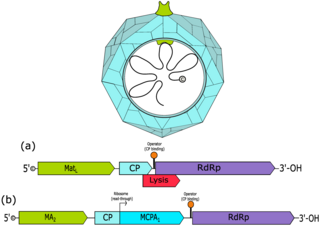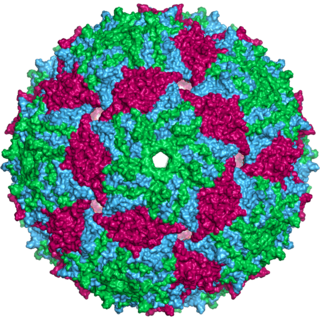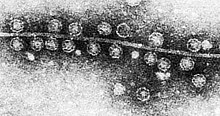
Barnaviridae is a family of non-enveloped, positive-strand RNA viruses. Cultivated mushrooms serve as natural hosts. The family has one genus, Barnavirus, which contains one species: Mushroom bacilliform virus. Diseases associated with this family includes La France disease.

Fiersviridae is a family of positive-strand RNA viruses which infect prokaryotes. Bacteria serve as the natural host. They are small viruses with linear, positive-sense, single-stranded RNA genomes that encode four proteins. All phages of this family require bacterial pili to attach to and infect cells. The family has 185 genera, most discovered by metagenomics. In 2020, the family was renamed from Leviviridae to its current name.

Totivirus is a genus of double-stranded RNA viruses in the family Totiviridae. Fungi serve as natural hosts. The name of the group derives from Latin toti which means undivided or whole. There are seven species in this genus.
Teschovirus is a genus of viruses in the order Picornavirales, in the family Picornaviridae. Pigs serve as natural hosts. There are two species in this genus, including Teschovirus A, which is responsible for the porcine enteroviral encephalomyelitis disease caused in pigs. The genus name comes from this species and the disease it causes: Teschen disease, which itself was named for the town Teschen in Poland/Czechoslovakia where the disease was first recognised in 1929.

Marnaviridae is a family of positive-stranded RNA viruses in the order Picornavirales. The first species of this family that was isolated is Heterosigma akashiwo RNA virus (HaRNAV) in the genus Marnavirus, that infects the toxic bloom-forming Raphidophyte alga, Heterosigma akashiwo. Using a sequence-based framework an additional twenty marine RNA viruses have been added to the family.

Alphanodavirus is a genus of non-enveloped positive-strand RNA viruses in the family Nodaviridae. Insects, mammals, and fishes serve as natural hosts. Diseases associated with this genus include: Nodamura virus paralysis in infected wax moth larvae. Member viruses can also provoke paralysis and death to suckling mice and suckling hamsters. There are five species in this genus.

Emesvirus is a genus of positive-strand RNA viruses, in the family Fiersviridae. Enterobacteria serve as natural hosts. There are three species in this genus. In 2020, the genus was renamed from Levivirus to its current name.
Mitovirus is a genus of positive-strand RNA viruses, in the family Mitoviridae. Fungi serve as natural hosts. There are five species in the genus.

Alvernaviridae is a family of non-enveloped positive-strand RNA viruses. Dinoflagellates serve as natural hosts. There is one genus in this family, Dinornavirus, which contains one species: Heterocapsa circularisquama RNA virus 01. Diseases associated with this family include host population control, possibly through lysis of the host cell.

Carmotetraviridae is a family of positive-strand RNA viruses. There is only one genus in this family, Alphacarmotetravirus, which has one species: Providence virus. Lepidopteran insects serve as natural hosts.
Avihepatovirus is a genus of viruses in the order Picornavirales, in the family Picornaviridae. Ducks and geese serve as natural hosts. There is only one species in this genus: Avihepatovirus A. Diseases associated with this genus include: fatal hepatitis.
Avisivirus is a genus of viruses in the order Picornavirales, in the family Picornaviridae. Turkey serve as natural hosts. There are three species in this genus.
Dicipivirus is a genus of viruses in the order Picornavirales, in the family Picornaviridae. Dog serve as natural hosts. There are two species in this genus.
Gallivirus is a genus of viruses in the order Picornavirales, in the family Picornaviridae. Turkey and chicken serve as natural hosts. There is only one species in this genus: Gallivirus A.
Hunnivirus is a genus of viruses in the order Picornavirales, in the family Picornaviridae. Cattle serve as natural hosts. There is only one species in this genus: Hunnivirus A.
Ichtadenovirus is a genus of viruses, in the family Adenoviridae. Fish serve as natural hosts. There is only one species in this genus: Sturgeon ichtadenovirus A.
Oscivirus is a genus of viruses in the order Picornavirales, in the family Picornaviridae. Birds serve as natural hosts. There is only one species in this genus: Oscivirus A.
Pasivirus is a genus of viruses in the order Picornavirales, in the family Picornaviridae. Pigs serve as natural hosts. There is only one species in this genus: Pasivirus A.
Rosavirus is a genus of viruses in the order Picornavirales, in the family Picornaviridae. Human and rodents serve as natural hosts. There are three species in this genus.
Sapelovirus is a genus of viruses in the order Picornavirales, in the family Picornaviridae. Pig serve as natural hosts. There are two species in this genus.








